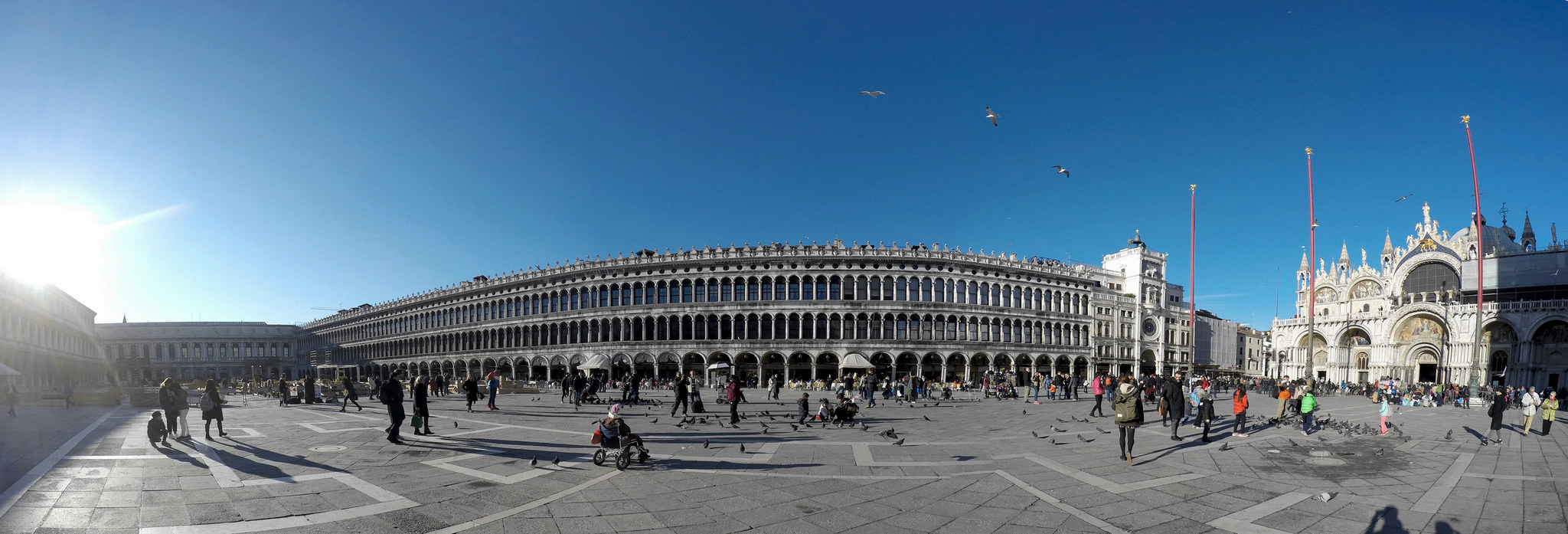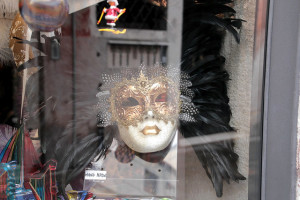 Venice, in the north of Italy, was on our list since a long time. To avoid queues and smelly water, and to avoid floods, we thought it was a good idea to go in winter! We just missed the carnival, but masks are readily available 🙂
Venice, in the north of Italy, was on our list since a long time. To avoid queues and smelly water, and to avoid floods, we thought it was a good idea to go in winter! We just missed the carnival, but masks are readily available 🙂
Ryanair flies from the national airport, and is still one of the cheapest airlines to fly with – if you don’t take any extras (including baggage). We took the morning flight, but to get to the airport at that time of the day by public transport is a disaster in Belgium … We missed our connecting train to the airport in Brussels, and shared a cab with other travellers which was good for our budget despite the extra unforeseen cost. That cab, although an official one, was a bit dubious – nope, a car shouldn’t shake! So we were glad we made it alive and on time.
Ryanair does not fly on the main airport of Venice, of course … Treviso is about an hour from Piazzala Roma, the main public transport hub. But we were very surprised to find out Ryanair sells cheaper tickets on board of the plane for the bus from Treviso to the city centre! Online, or on the airport, you pay 22 euro for a return ticket (valid for two weeks). Ryanair sells them at 18 euro … (or single: €10 instead of €12).
When we arrived the weather wasn’t so friendly for us, with a lot of wind and rain. Wintertime you know … When it stopped after a while we could walk relatively dry to our hotel, in the area Dorsoduro. This must be the only city in the world where a car is not allowed in the centre (and it wouldn’t be possible to drive either). But it was also strange to notice there are practically no bikes, but since there are at least at thousand (foot)bridges it does make sense …
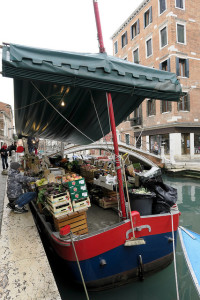 Dorsoduro is not that touristy, compared to other areas with San Marco on top. Except for all the bridges, there must also be at least a thousand churches in this city! We’ve never seen anything like this before. We’ve only found one synagoge in the old jewish quarter in Cannaregio, and no mosques. But back to Dorsoduro. We started our expedition at Campo Santa Margherita, just around the corner of our hotel, very convenient! With some market stalls, a lot of places to drink or eat and a few trees, it is a very charming square, boosting a local ambience. Along Campo Carmini and Santa Maria de Carmini, we ended up at the Canale della Giudecca. The walk along Fondamente Zattere is a very nice one, on a spacious boulevard. Be sure to go inside small alleys or make some detours.
Dorsoduro is not that touristy, compared to other areas with San Marco on top. Except for all the bridges, there must also be at least a thousand churches in this city! We’ve never seen anything like this before. We’ve only found one synagoge in the old jewish quarter in Cannaregio, and no mosques. But back to Dorsoduro. We started our expedition at Campo Santa Margherita, just around the corner of our hotel, very convenient! With some market stalls, a lot of places to drink or eat and a few trees, it is a very charming square, boosting a local ambience. Along Campo Carmini and Santa Maria de Carmini, we ended up at the Canale della Giudecca. The walk along Fondamente Zattere is a very nice one, on a spacious boulevard. Be sure to go inside small alleys or make some detours.
The Fondamente takes you to Punta della Dogana, from where you can see San Marco, the Doge’s Palace and San Giorgio. The Basilica Santa Maria de Salute is free to enter, young (relatively speaking, 17th Century, built after a plague outbreak) and very impressive, both on the outside and on the inside! Our route took us further along the Canal Grande, which meanders across the city, the Peggy Guggenheim museum, the Galleria d’Academia, towards a special bridge: the Ponte dei Pugni. On the bridge, rival gangs met each other to fight (pugni means fist). The footprints on the bridge point out the place where the fightings started. From there it is only a short walk to the Campo San Barnaba. As we are in Venice, everything from transport of goods to garbage collection and even funerals happens on the water. So it cannot be surprising to find a vegetable boat on one of the many canals 🙂
Crossing the Rio Froscari, you enter San Polo. In this area (or in the entire city for that matter), there is one church that must absolutely be on everyone’s to see-list: the San Pantolon church. It is not a big church, nor a very ornamented one. To see why it is special, you have to look up! The ceiling is just mind-blowing! San Polo fuses with Santa Croce. Together they form the ‘inner island’ of Venice. This is the place where the earliest settlements were found.
Here you’ll find the most important ‘Scuola Grande’: San Rocco, at the Campo San Rocco and the namesake basilica. The Scuola is the school of the earlier guilts, and houses about 56 paintings of Tintoretto. The basilica dei Frari is just around the corner, but you have to pay an entrance fee. A lovely place to rest is the Campo di San Giacomo dell’ Orio. The church has been built in the 9th Century and is still standing strong! Unfortunately there is an entrance fee, but I had a quick look at the wooden ceiling anyway, which is absolutely beautiful!
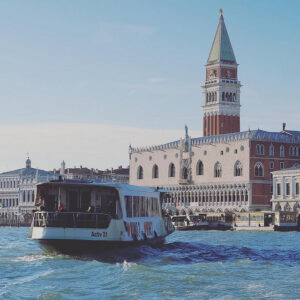 You must have figured out by now we’ve been walking a lot, although there are so many canals and – obviously – boats. There is a good reason to do so: unless you are very wealthy, or you don’t mind to crack your budget, taking those boats (also public ones!) is just very expensive! We’ve planned our second day in that way we were going to take many rides on the boat. If you pay €20 for a day-ticket (24 hours) per person, you just have to take the most out of it! We ended up taking the boat 13 times! (€7 per single ticket, we saved a lot of money!)
You must have figured out by now we’ve been walking a lot, although there are so many canals and – obviously – boats. There is a good reason to do so: unless you are very wealthy, or you don’t mind to crack your budget, taking those boats (also public ones!) is just very expensive! We’ve planned our second day in that way we were going to take many rides on the boat. If you pay €20 for a day-ticket (24 hours) per person, you just have to take the most out of it! We ended up taking the boat 13 times! (€7 per single ticket, we saved a lot of money!)
We started our second day very early and got on the boat during rush hour. Along a part of the Canal Grande, we sailed to Murano. The express boat takes you there in about 20 minutes (No. 3). Murano is known for its glass blowers. And it is just a nice little island as well. Since we arrived quite early, we had the place for ourselves! But unfortunately, we were also a bit too early to actually see glass blowers at work. We did get to see a workplace, and of course a lot of shops. From Murano, we took the boat back to the city centre, but not without stopping en route at San Michele. This is the cemetery of Venice, a complete island yes indeed, with its own church (which was already built in the 15th Century)! We even saw how a coffin was brought ashore. It is a bit spooky to visit cemeteries, but to us it is just an alternative way of getting in touch with a culture. Back to Venice itself then. We got of the boat at Madonna dell’Orto, on the northern side of the quarter Cannaregio. Here you get to know an other face of Venice.
A community of Jewish people lives in this part of town, in what is described in guides and on maps as ghetto’s. Not sure what the Jews think of this, since there is kind of a negative connotation around this word … Anyway, you cannot deny where the Jews live. This must be the only place in Venice where you can find another kind of worship place (e.g. the synagogue) (a few intresting articles about the jews in Venice: 500 years of jewish life in Venice and 500 years of Venetian ghetto) as anywhere in the world, important Jewish places are guarded by the army … After exploring this less touristic area, we took another boat (No. 4.1 and 4.2) to discover the Canal Grande (at a cheap price compared to the price of a gondola which costs € 80 for 30 minutes). A city looks different viewed from the crystal blue water! The façades are absolutely beautiful! And it is amazing to see how traffic is organized as well. Still hungry for more water and boat-rides, we went to the little island of San Giorgio. This is only a 5-minute ‘drive’ from San Zaccaria, just behind San Marco Square. The reason to go there is not the island, but the San Giorgio Bell Tower, from where you have an absolutely fabulous view over Venice and its surroundings! It is cheaper (€ 6 per person, church and toilet are free) and far less crowdy than the Campanile Bell Tower on San Marco Square, so that is a bonus!

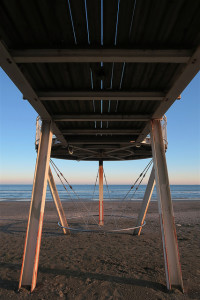 Back on the main land, we decided we hadn’t taken everything out of our day-pass yet, so we went to Lido. The beaches of Venice … To be quite frankly, we wouldn’t advice anyone to go there if you don’t have time. The main beach isn’t that fancy! We did enjoy a gorgeous sunset on our way back to the main island. After a quick stop (with the boat) at our hotel, and a cheap dinner, we took another boat to discover the Canal Grande by night. The façades were even more beautiful than at daytime! Surprisingly, all the crowds were disappeared at the San Marco Square, so we could soak in the atmosphere by night without being extremely attentive to our bags. However, the day-street-hawkers were replaced by night-street-hawkers, and they are even more obtrusive. Our second day ended with a last boattrip back to our hotel.
Back on the main land, we decided we hadn’t taken everything out of our day-pass yet, so we went to Lido. The beaches of Venice … To be quite frankly, we wouldn’t advice anyone to go there if you don’t have time. The main beach isn’t that fancy! We did enjoy a gorgeous sunset on our way back to the main island. After a quick stop (with the boat) at our hotel, and a cheap dinner, we took another boat to discover the Canal Grande by night. The façades were even more beautiful than at daytime! Surprisingly, all the crowds were disappeared at the San Marco Square, so we could soak in the atmosphere by night without being extremely attentive to our bags. However, the day-street-hawkers were replaced by night-street-hawkers, and they are even more obtrusive. Our second day ended with a last boattrip back to our hotel.
Day 3 got an early start, again! Our 24-hour pass was valid until about 8.15 AM, and since the Rialto Market (Rialto Mercato) was a fair bit of walking from our hotel, we decided to take a boat for the last time. The earliest proof of commerce at this place dates from the early 11th Century. We expected the market was going to be bigger, and covered. A little bit disappointing … Just some fruit & veggies and the fish market. And the Rialto Bridge is being renovated (but it is more than 500 years old. On the other hand, we came early enough to avoid big crowds (which we discovered later on the day when we returned).
From the Rialto area, we walked to another part of Venice: Castello. A bit hidden, and away from the big sights: the Chiodo Bridge. Small, and it goes to a private house. So what’s special about it? Well, it is the only bridge in the whole of Venice without rails! Apparently this was how all the bridges looked like back in the days. From here it is not that far to the Campo del SS. Giovani e Paolo. The Scuola Grande is next to a public hospital with free toilets. But more important is the church here, which holds the remains of the doges. Both buildings are, again, magnificent!
We found our way back to the San Marco area, which covers more than the square of course. The Giardini ex Reali is an absolute no go! One of the ugliest gardens ever seen … The Campo San Stefano is a nice and spacious people-watching square. The crooked tower belongs to the San Stefano Church. The San Maurizio Square is a nice place to relax and enjoy the music from the church which houses the Music Museum. A very ornamented, baroc church is the Santa Maria del Giglio Church at the Campo de Giglio (didn’t enter though – entrance fee).
However, it is an absolute must to enter the Basilica di San Marco. 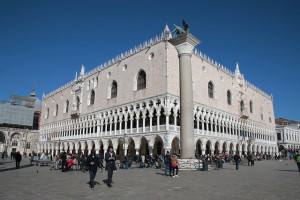 After all, the square and basilica are listed as World Heritage. The entrance is free, but you’re not allowed to take your bag with you. And you have to stand a bit of a crowd. But once inside, you’ll be amazed of the wealth of the catholic church … The square has a history dating back to the early medieval times. The oldest buildings (the Campanile and the Basilica) were build in the 12th Century. Before, the square was a garden of the sisters of the Zaccaria convent. The Doge’s Palace (Palazzo Ducale) was the decision-making heart of Venice for centuries, and a magnificent building. The Bridge of Sighs is just around the corner. A better way to take a picture of it (at least, a funny way) is to go to one of the bridges at the other side. The history of this bridge is not that funny though. It was the last time prisoners could see any daylight before being hidden away in the dungeons of the prison. Strange how the tradition arose kissing by sunset under the bridge will bring eternal love …
After all, the square and basilica are listed as World Heritage. The entrance is free, but you’re not allowed to take your bag with you. And you have to stand a bit of a crowd. But once inside, you’ll be amazed of the wealth of the catholic church … The square has a history dating back to the early medieval times. The oldest buildings (the Campanile and the Basilica) were build in the 12th Century. Before, the square was a garden of the sisters of the Zaccaria convent. The Doge’s Palace (Palazzo Ducale) was the decision-making heart of Venice for centuries, and a magnificent building. The Bridge of Sighs is just around the corner. A better way to take a picture of it (at least, a funny way) is to go to one of the bridges at the other side. The history of this bridge is not that funny though. It was the last time prisoners could see any daylight before being hidden away in the dungeons of the prison. Strange how the tradition arose kissing by sunset under the bridge will bring eternal love …
We’ve seen quite a bit of Venice. We enjoyed it, and hope you’ve enjoyed our story and pictures!
a few interesting articles: top 10 free things to see in Venice / visiting Venice on a budget / Venice, what to see and do in Winter
Some tips:
– Don’t go in summer.
– If you fly with Ryanair, buy your ticket to the city centre on board of the plane. First Euro’s saved!
– Go to little places to eat, like Al Volo for pizza (Campo Santa Margherita), or Bigoi (San Polo) or Dal Moro’s Fresh Pasta to Go (San Marco). Cheap but so delicious!
– Buy a day-pass for public transport, and plan your day. Take the most out of it, since public transport is expensive!
– A lot of churches ask an entrance fee. A lot though are for free and are just as beautiful
– If you want to go inside a Scuola Grande or a museum, check beforehand if there are discounts or joint passes available. It could save you a lot of money. We had some listed in case the weather would be disappointing, but we didn’t have to use it
– Don’t go to the Campanile, but to the San Giorgio Bell Tower to avoid a mass (and it’s cheaper)
– If you want to discover the Canal Grande, and you don’t want to break your travel budget, use a public boat, not a gondola
– Rely on your inner compass, not necessarily on a street map
Venice 2016 from Travel for Motion on Vimeo.
